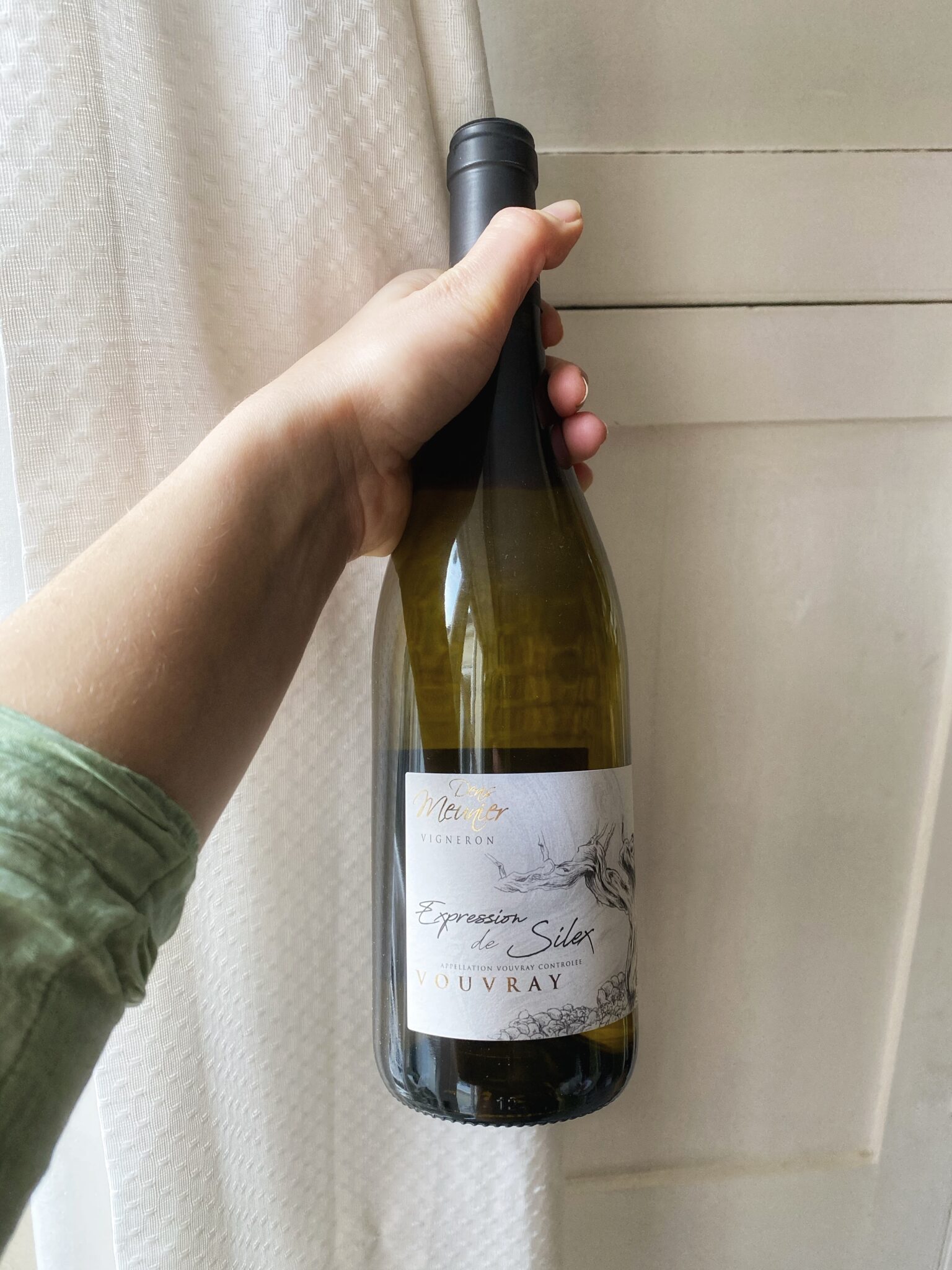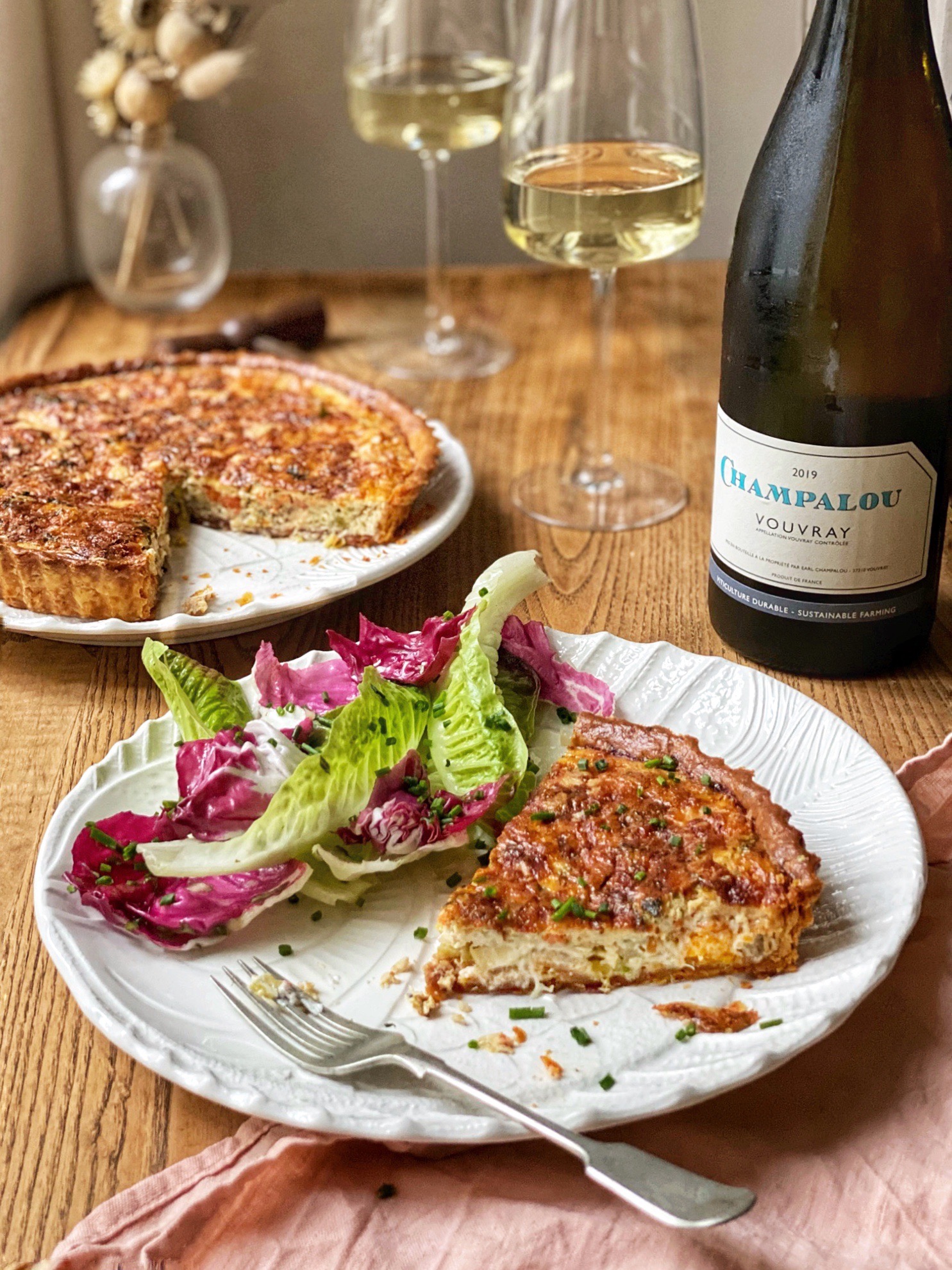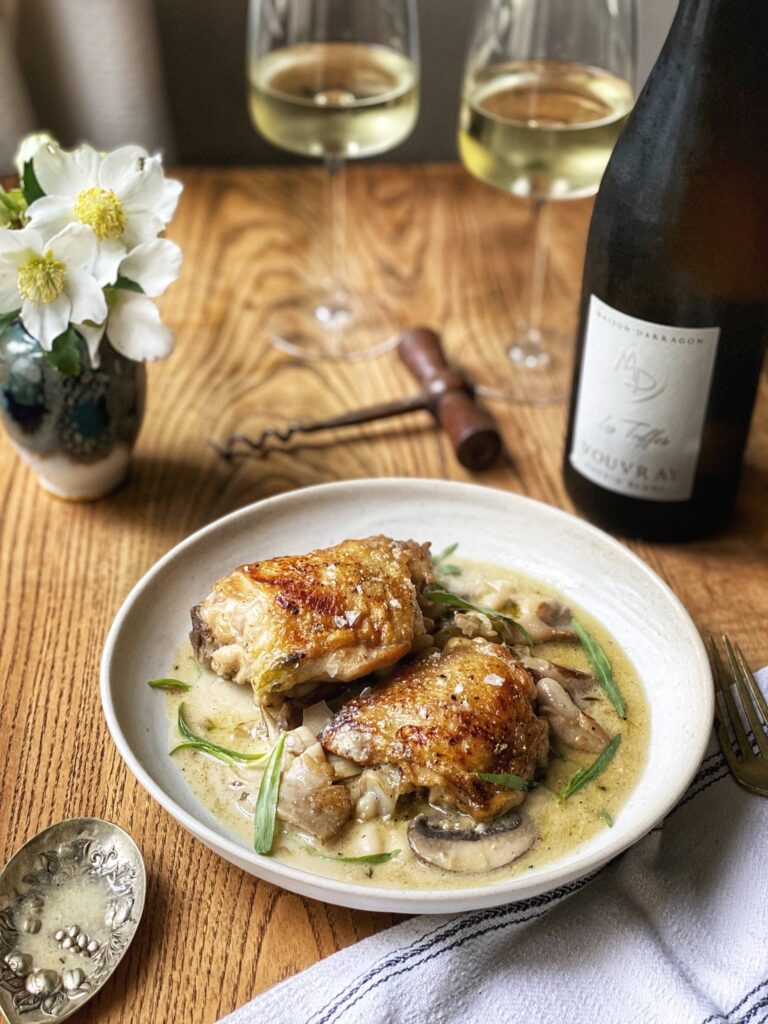*This post is part of a sponsored campaign with Vouvray Wines
Exploring different countries and regions through the wine they produce is a wonderful way to travel vicariously, and I don’t know about you, but I’ve been craving French wine, French culture and the general French approach to food and drink, especially with everything that’s going on in the world right now. When Vouvray – the most respected of the Loire’s Touraine growing regions – approached me to work with them on some recipes to match to the appellation’s wonderful wines, I was thrilled to jump on the project, and I’m excited to share both my recipes and my matches with you here.

While I’ve been massively missing eating out in restaurants this year, and especially since we went into Tier 3, I’ve been making a concerted effort to approach some of our meals at home – particularly on the weekends – as more of a special occasion, and in the same vein, relish the chance to really think about pairing a particular wine with a certain dish. One of my favourite things about eating out is the way you approach drinking alongside your meal, as for me at least, it’s quite different to what we do at home – which tends to be to open a bottle of whatever we have to hand to drink while we cook. When you eat out, depending on the tone of the restaurant – whether it’s fancy or more casual – you’ll undoubtedly be ordering some wine from a wine list, perhaps even getting a recommendation from the knowledgeable front of house staff or sommelier in terms of what to drink with your meal, and which elements of the wine with pair well with the flavours in your chosen dishes. I love how this often pushes you to try new wines or styles of wines that you might not have known about, perhaps opening a bottle of something you’d be unlikely to have at home, and a good match means that both the food and wine do their delicious jobs even better.
Vouvray is a wine that I haven’t previously had huge experience with, but the thing that became apparent when I was tasting the wines during my research, was just how diverse and versatile the appellation is. It includes sweet, dry, still and sparkling wines, from eight villages around the town of Vouvray on the northern banks of the mighty Loire river. The main grape is Chenin Blanc, which is naturally very high in acidity, while also being incredibly aromatic – and these two things also mean that the wine ages well, developing and opening up as it matures. As I’m sure you can imagine, I certainly enjoyed the ‘research’ side of things for this job, and was really impressed by the quality and diversity of the wines I tried. The sparkling Champalou brut wine was something of a revelation, with delicate, fine creamy bubbles, hints of floral honey and ripe fruit on the nose – certainly a wine I’ll be serving to kick off future dinner parties, whenever those can resume again.
 When researching the wines, I was thrilled to learn more about the heritage of some of the wineries, and about the ‘respect for terroir’ shown by so many of the growers, many of whom are choosing to work using lower-intervention methods, like Denis Meunier, who took over his 13 hectares of Chenin Blanc from his father and uncle in 2012. Over time, he’s been moving the domaine towards organic farming (High Environmental Value certification*), working to protect the soil, which is made up of the tuffeau (local limestone) and clay-silex soils distinct to Vouvray. His wine has a lively, bright citrus nose and works very well served with fish and seafood. It’s the ideal match for a platter of oysters or peeled prawns with homemade mayonnaise.
When researching the wines, I was thrilled to learn more about the heritage of some of the wineries, and about the ‘respect for terroir’ shown by so many of the growers, many of whom are choosing to work using lower-intervention methods, like Denis Meunier, who took over his 13 hectares of Chenin Blanc from his father and uncle in 2012. Over time, he’s been moving the domaine towards organic farming (High Environmental Value certification*), working to protect the soil, which is made up of the tuffeau (local limestone) and clay-silex soils distinct to Vouvray. His wine has a lively, bright citrus nose and works very well served with fish and seafood. It’s the ideal match for a platter of oysters or peeled prawns with homemade mayonnaise.
*High environmental value (HEV) corresponds to the highest level of a more general scheme of environmental certification for farms. The farm environmental certification is a voluntary approach which aims to identify and promote particularly environmentally-friendly practices applied by farmers. HEV covers four key areas: biodiversity conservation, plant protection strategy, management of fertiliser use and management of water (agriculture.gouv.fr).

At the Vigneau Chevreau domaine (biodynamic like Domaine Huet), which has been producing wine since 1875, there are 30 hectares of exclusively Chenin Blanc wines, and cave-like cellars built deep into the hillside for ageing. The Cuvee Silex is expressive and distinctly floral, with notes of baked apple, orange and honey with a wonderful underlying savouriness – at once distinctly dry but with great depth and purity. Again, wonderful with seafood, or as an aperitif.
To match with my recipes, which are fairly rich, ‘wow’ dishes focused around shellfish, cheese and poultry, I plumped for two still wines – both ‘sec’ – meaning dry, but even within that category both wines display wonderful points of difference that speak to the richness of the appellation, and I would really encourage you to seek their wines out to try for yourself, along with both of these recipes. I’ve been teasing everyone with the leek, crab and Comte tart for quite some time on Instagram, and it just so happens to pair beautifully with Vouvray, so I’m thrilled to have the opportunity to share it here – it’s perfect for a celebratory lunch or starter, would be ideal for Christmas eve and is perfect for making ahead and then busting out effortlessly. The chicken stew is a super simple one-pot wonder, but it feels very French and sophisticated to me, thanks to the tarragon, mushrooms and luxurious boost from the double cream. It reminds me of a rabbit dish I was once served on a vineyard in France, in fact. It’s comforting, but also sumptuous enough to serve for a special supper, and I love the fact it saves on washing up. I hope you enjoy.
As part of my research for this, I had the pleasure of trying a variety of wines from the following winemakers, so a big thank you to them:
- Vouvray Sec Denis Meunier
- Vouvray Sec Champalou
- Vouvray Sec Alain Robert&Fils
- Vouvray Sec Maison Darragon
- Vouvray Brut Sylvain Gaudron
- Vouvray Brut Domaine de la Chataignerie
- Vouvray Demi Sec Domaine Huet
- Vouvray Moelleux Domaine des Aubuisieres
Recipes to cook with Vouvray
For the Leek, Crab and Comte Tart
For the pastry
150g plain flour
½ tsp salt
90g very cold butter, cubed
50g aged comte, coarsely grated
1 tbsp vodka
2-3 tbsp iced cold water
1 egg, lightly beaten
For the filling
A knob of butter (about 10-15g)
a tbsp of extra virgin olive oil
½ a leek, finely sliced
A pinch of fennel seeds
½ fennel bulb, finely chopped (fronds reserved for garnish)
freshly ground white pepper
2 tbsp dry white wine (I used Vouvray sec)
1 tbsp lemon juice
200g dressed crab, white and brown meat divided
A few leaves of tarragon, finely chopped (or pinch of dried tarragon)
A handful of parsley, finely chopped
½ tsp ground cayenne pepper
Nutmeg, for grating
2 eggs
200g full fat creme fraiche
75g aged Comte cheese, grated
For the Chicken, Tarragon and Mushroom Bean Stew
Sea salt and freshly ground white pepper
4 organic, skin on, bone-in chicken thighs
2 tbsp extra virgin olive oil
2 sprigs of thyme
2 shallots, peeled and finely chopped
1 clove of garlic, minced
A handful of tarragon leaves
100g oyster or chanterelle mushrooms
100g chestnut mushrooms, sliced
150ml dry white wine (I used Vouvray sec)
600ml chicken stock
400g tin of cannellini beans, drained and rinsed
A spritz of lemon juice
2 tbsp double cream
For the Crab, Leek and Comte tart

- Chill your butter in the freezer for ten minutes to get it super cold. In the bowl of a food processor, combine the flour, salt and grated cheese, blitzing together briefly to combine. Add in the butter and pulse to combine to coarse breadcrumb consistency. Now scatter over the vodka and 2 tbsp of the water and blitz again until it starts sticking and clumping together. At this point you want to tip it into a bowl, and use your hands to bring it all together, briefly kneading until smooth. Press into a disc, wrap in greaseproof paper and chill in the fridge for at least an hour.
2. One rested, lightly flour a work surface and unwrap your pastry. Use your rolling pin to bash the pastry, flattening the disk evenly, then roll it out to pound coin thickness and line a 20cm diameter tart tin with it. I use an excess piece of pastry to press the pastry into and up the edges of the tin, and then a fork to pierce little holes all over the base, not pressing all the way through the pastry. Once lined, chill the tart case in the fridge for 15 minutes, while you heat the oven to 160 fan.
3. Line the pastry with crumpled baking paper, fill the case with baking beans and blind bake for 20 minutes. After this time, remove beans, use the beaten egg to egg wash to pastry, then bake for another 20 minutes, until nicely golden. Allow the tart case to cool while you prep the filling. In a heavy based, non-stick frying pan over a medium heat, fry the leek and fennel gently in the butter and olive oil with the fennel seeds, a pinch of salt and white pepper for about five minutes, until softened and buttery but not colouring. Now deglaze the pan with the wine and cook off the alcohol for a minute or so, until the liquid has evaporated. Stir in the parsley, spritz over the lemon juice and stir.
4. Crack the eggs into a mixing bowl and whisk them together with the creme fraiche, brown crab meat, half the cheese and the tarragon. Season well with nutmeg, the cayenne pepper and a bit more salt. Cover the base of the tart case with the leek and fennel mix, and then dot over the white crab meat. Carefully pour over the custard, making sure you don’t fill it right up to the top of the pastry as the filling will rise a little*. Scatter over the rest of the cheese and strew over the remaining fennel fronds and bake at 170 fan for 25-30 minutes, until puffed and golden. Allow to cool and settle for at least 15 minutes before slicing and serving. It’s perfect with a sharply dressed lettuce and bitter leaf salad, and a glass of Champalou Vouvray
*Any leftover custard is perfect whisked into eggs for luxury scrambled eggs while the tart bakes.
Wine Match: Vouvray Champalou Sec
I chose this wine for the crab tart, because as well as the gorgeous balance of minerality and fruit in this wine. There is wonderful freshness and delicacy that pair really beautifully with the shellfish, and also cuts nicely through the richness of the cheese and pastry. Because this wine is aged on its fine lees, there is also a lushness and body to the wine which I enjoy. I also really appreciate this winemaker’s approach to viticulture: the vineyard is maintained following sustainable farming methods which respect the microbiological life of the ground and water and really allow the chenin blanc grapes to sing. Additionally, the vine and wine production are certified Terra Vitis, respecting the environment. Delicious and sustainable, which are always big ticks from me.
For the Chicken, Tarragon and Mushroom Bean Stew

- Season the chicken well with salt and white pepper. Set a heavy-bottomed non-stick or cast iron frying pan or skillet over a low-medium heat and pour in the oil. Swirl in the thyme and then place the chicken, skin side down, in the pan, pressing it down with a wooden spoon or spatula. Let the chicken skin caramelise and the fat render, uninterrupted, for a good 8-10 minutes, until golden, crispy and crusted, then turn the thighs over and colour the rest of the chicken. Remove from the pan with tongs and set aside on a plate.
Add the butter into the pan with the chicken fat, along with the shallots, garlic, mushrooms and tarragon, and turn the heat up slightly, then season and cook, stirring, for 5-6 minutes, until the shallots have softened and the mushrooms have caramelised and reduced.
2. Deglaze the pan with the wine, scraping your wooden spoon along the bottom of the pan so it picks up the crusty goodness from browning the chicken, and then place the chicken back into the pan. Pour in the stock, around rather than on top of the chicken, bring to the boil and skim off any scum that’s released from the chicken. Turn the heat down and simmer the thighs for 35-40 minutes, until a thermometer pressed into the thickest part of the thigh reads 75 degrees celsius, and the liquid has significantly reduced, but is still brothy.
3. Stir in the beans, spritz with the lemon and then pour in the cream, stirring to combine. Cook for a couple more minutes, until the beans are warmed through, then garnish with extra tarragon.
Match: Les Tuffes – Maison Darragon Sec
This wine is made on a 40 hectare estate by Pierre Darragon and husband and wife team Christelle, his daughter, and David Charbonnier. The Darragon vineyards lie on the region’s famous chalky, clay-limestone terroir and the resulting wine is expressive with white fruit, green apple and a hint of citrus. It has a lovely freshness to it which cuts through the richness of this dish beautifully, while also retaining a purity of fruit, and body that I love, thanks to the ageing of the wine, which takes place in the ancient cave cellars on the estate before its sold. The family practises sustainable agriculture, tending to the biodiversity of their vineyards by growing grasses between the vines, encouraging microorganisms and respecting the environment they work in.
